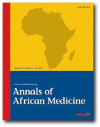
|
Annals of African Medicine
Annals of African Medicine Society
ISSN: 1596-3519
Vol. 9, No. 3, 2010, pp. 188-193
|
 Bioline Code: am10042
Bioline Code: am10042
Full paper language: English
Document type: Research Article
Document available free of charge
|
|
|
Annals of African Medicine, Vol. 9, No. 3, 2010, pp. 188-193
| fr |
Gajida, A. U.; Iliyasu, Z. & Zoakah, A. I.
Résumé
Arrière-plan : Le paludisme de grossesse reste un problème majeur de santé en particulier en Afrique subsaharienne.
Cependant, la prévalence de l’infection clinique et asymptomatique parmi les participants prénatals client (ANC)
est en grande partie inconnue, notamment au niveau des soins de santé primaires (HCP) dans le Nord du Nigéria.
Cette étude a évalué la prévalence de la peste, malarienne parasitemia et l’anémie chez les femmes enceintes qui
fréquentent les installations HCP dans Kano, Nord du Nigéria.
Méthodes : Une étude descriptive transversale a été menée entre 360 ANCs qui fréquentent les installations HCP dans
deux locaux zone d’administration (LGAs) dans l’Etat de Kano. Données ont été recueillies à l’aide d’un pré-testées
semi-structuré questionnaire de l’interviewer administré. Les échantillons de sang ont été obtenus également pour
les frottis sanguin mince pour le paludisme parasite à l’aide de Giemsa coloration technique. Hémoglobine a été
estimée de la paniers cellules volume (PCV) déterminé en utilisant hématocrite.
Résultats : Âge des sujets allant de 15 à 42 ans, avec une moyenne ± SD de ± 24,0 6.0. Jusqu’à 39.2 % (n = 141) (95
% Témoignage a Confi intervalle = 34.1–44.4 %) des sujets ont eu parasitemia malarienne. Exactement 36.2 % (n
= 51) de ceux avec parasitemia avaient la peste (température ≥ 37 .5oC) tandis que 63.8 % (n = 90) d’entre eux ont
été asymptomatiques. Anémie, (hémoglobine de ≤ 11 g/dl) a été trouvé dans 48,1 % (n = 173) des répondants. Une
proportion plus élevée de primigravid et secondigravid clients (61 % VS 39 %) et les jeunes femmes enceintes (54,6 % VS 45,4 %) avaient parasitemia malarienne comparativement aux femmes multigravid et anciennes, respectivement.
De même, une important considérablement plus grande proportion (67,6 %) d’anémique Les clients ANC avaient
parasitemia malarienne. ( ÷ 2 = 113.25, df = 1, P < 0,05).
Conclusion : Malarienne infection est fréquent chez les clients ANC qui fréquentent les installations HCP dans l’Etat
de Kano et la infection est généralement associée à l’anémie. Traitement préventif intermittent (IPT) doivent être
fournis en particulier Parmi les primigravid, secondigravid et jeunes mères dans les centres HCP.
Mots Clés
Clients prénatals, le paludisme, les établissements de soins de santé primaires
|
| |
| en |
Malaria among antenatal clients attending primary health care facilities in Kano state, Nigeria
Gajida, A. U.; Iliyasu, Z. & Zoakah, A. I.
Abstract
Background: Malaria in pregnancy remains a major public health problem especially in sub-Saharan Africa. However, the prevalence of clinical and asymptomatic infection among antenatal client (ANC) attendees is largely unknown, especially at primary health care (PHC) level in northern Nigeria. This study assessed the prevalence of fever, malarial parasitemia and anemia among pregnant women attending PHC facilities in Kano, northern Nigeria.
Methods: A cross-sectional descriptive study was conducted among 360 ANCs attending PHC facilities in two Local Government Areas (LGAs) in Kano state. Data were collected using a pre-tested semi-structured interviewer administered questionnaire. Blood samples were also obtained for thin blood smear for malaria parasite using Giemsa staining technique. Hemoglobin was estimated from the Packed Cell Volume (PCV) determined using hematocrit.
Results: Age of the subjects ranged from 15 to 42 years with a mean ± SD of 24.0 ± 6.0. Up to 39.2% (n = 141) (95% Confi dence Interval = 34.1-44.4%) of the subjects were found to have malarial parasitemia. Exactly 36.2% (n = 51) of those with parasitemia had fever (temperature ≥ 37.5oC) while 63.8% (n = 90) of them were asymptomatic. Anemia, (hemoglobin of ≤11 g/dl) was found in 48.1% (n = 173) of the respondents. A higher proportion of primigravid and secondigravid clients (61% vs. 39%) and younger pregnant women (54.6% vs. 45.4%) had malarial parasitemia compared to multigravid and older women, respectively. Similarly, a signifi cantly higher proportion (67.6%) of anemic ANC clients had malarial parasitemia. (χ2 = 113.25, df = 1, P < 0.05).
Conclusion: Malarial infection is common among the ANC clients attending PHC facilities in Kano state and the infection is commonly associated with anemia. Intermittent Preventive Treatment (IPT) should be provided especially among primigravid, secondigravid and younger mothers at PHC centres.
Keywords
Antenatal clients, malaria, primary health care facilities
|
| |
© Copyright 2010 Annals of African Medicine.
Alternative site location: http://www.annalsafrmed.org
|
|
